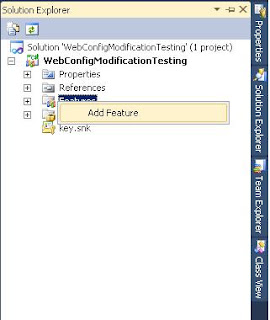One of requirement in my
project was to edit the web.config of the current SharePoint
web application.There are many other articles and posts discussing the same
topic, however many people had the same issue that I was faced during modifying
web.config file
1.
It adds multiple entries into web.config file
where it should only add one single entry.
2.
It does not delete entries from web.config
file.
After the doing some R&D on that part, I got the
solution to add/remove entries from particular site.The requirement was to add the following line into providers section of web.config file on Activating feature and delete from same on deactivating feature.
Then
here are the steps to create a Feature that will add entries to the web.config
for the SharePoint Web Application
1. Open Visual Studio 2010.
2. Select New -- Project -- Empty SharePoint Project
3. Provide a local site and Select “Deploy as a farm solution” option.
4. Right Click on the “Features” and Select “Add Feature”
2. Select New -- Project -- Empty SharePoint Project
3. Provide a local site and Select “Deploy as a farm solution” option.
4. Right Click on the “Features” and Select “Add Feature”
5. Double click on feature and provide the Unique Title Name and Description and also Set Feature scope is “Site”
6. Right Click on Feature1.Feature and Click on “Add Event Receiver”
using Microsoft.SharePoint.Security;
using Microsoft.SharePoint.Administration;
using System.Collections.Generic;
using System.Reflection;
8. Add following common variables and method before
FeatureActivated Method
string providerName = "ITCollabTopNavProvider";
string proviDerdescription
= "Custom ITCollab provider for top navigation
in Portal Usage pages";
string providerType
= "WebConfigModificationTesting.ITCollabTopNavProvider,
WebConfigModificationTesting, Version=1.0.0.0, Culture=neutral,
PublicKeyToken=0840b76c1e94278b";
string providerNavType
= "Current";
string providerEncodeOutput
= "true";
string Owner = "Pravin";
privatestring psSiteUrl = "";
private void __getSiteURL(SPFeatureReceiverProperties properties)
{
SPSite site = null;
// Get a reference to the site
collection of the feature
if (properties.Feature.ParentisSPWeb)
{
site = ((SPWeb)properties.Feature.Parent).Site;
}
elseif (properties.Feature.ParentisSPSite)
{
site = properties.Feature.ParentasSPSite;
}
if (site != null)
{
psSiteUrl = site.Url;
}
}
9. Add the following Code in FeatureActivated Method
public override void FeatureActivated(SPFeatureReceiverProperties properties)
{
__getSiteURL(properties);
SPWebApplicationwebApp = SPWebApplication.Lookup(newUri(psSiteUrl));
SPWebService service = SPWebService.ContentService;
//Add Provider URL
SPWebConfigModificationproConfigMod = newSPWebConfigModification();
proConfigMod.Owner
= Owner;
proConfigMod.Path
= "configuration/system.web/siteMap/providers";
proConfigMod.Name = String.Format("add
[@name='" + providerName + "']
[@description='" + proviDerdescription + "']
[@type='" + providerType + "']
[@NavigationType='" + providerNavType + "']
[@EncodeOutput='" + providerEncodeOutput + "']");
proConfigMod.Value = String.Format(""
, providerName,
proviDerdescription, providerType, providerNavType, providerEncodeOutput);
proConfigMod.Type = SPWebConfigModification.SPWebConfigModificationType.EnsureChildNode;
webApp.WebConfigModifications.Add(proConfigMod);
webApp.Update();
service.ApplyWebConfigModifications();
10. You also need to add code to remove the entry when the Feature is deactivated.
public override void FeatureDeactivating(SPFeatureReceiverProperties properties)
{
SPWebApplicationwebApp = SPWebApplication.Lookup(newUri(psSiteUrl));
try
{
RemoveEntries(webApp);
webApp.Update();
webApp.Farm.Services.GetValue<SPWebService>().ApplyWebConfigModifications();
webApp.WebConfigModifications.Clear();
}
catch (Exception ex)
{
throw ex;
}
}
//Remove
Entries made to web.config by Owner name “Smartrider” private void RemoveEntries(SPWebApplicationwebApp)
{
try
{
List<SPWebConfigModification>entriesToRemove
= newList<SPWebConfigModification>();
foreach (SPWebConfigModificationconfigModinwebApp.WebConfigModifications)
{
if
(configMod.Owner == "Pravin")
{
entriesToRemove.Add(configMod);
}
}
if
(entriesToRemove.Count> 0)
{
for (inti = entriesToRemove.Count - 1; i>= 0; i--)
{
webApp.WebConfigModifications.Remove(entriesToRemove[i]);
}
}
}
catch
{
throw;
}
}11. Deploy the code and check the web.config file to verify your entries.Deactivating the feature will remove that line and leave the web.config clean of our site web.config



